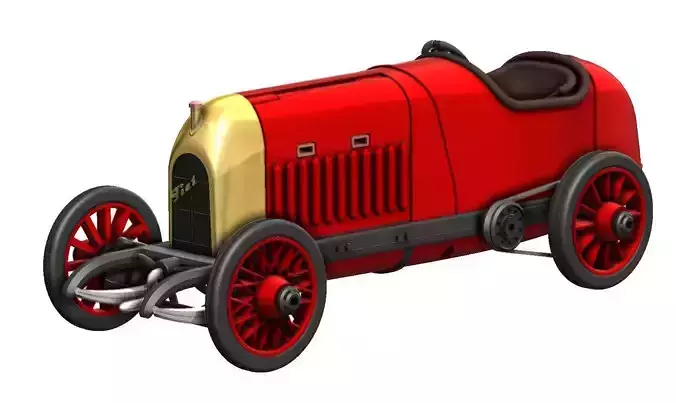1/35
The Fiat S76, famously nicknamed “The Beast of Turin”, was one of the most ferocious and ambitious racing cars ever built. Conceived in 1910 to break speed records, it housed a monstrous 28.5-liter inline-four engine producing nearly 300 horsepower — an engineering marvel of its time. My 3D printable 39 cm model brings this legendary machine to life as a detailed, motorized desktop display. The model consists of 49 carefully designed parts, including opening motor hoods, functional front steering, and two interchangeable wheel sets (classic straight spokes and snowflake-style). The centerpiece is its working miniature engine — simplified for easy assembly but fully functional, with moving pistons visible through side peek holes. The engine connects to a DC gear motor (a 3D reference model is included for fitting), which drives the pistons and wheels in motion. Without the motor, motion can still be achieved via the manual starting crank at the front, preserving the car’s authentic spirit. Mounted on its included display stand, it becomes both a technical showcase and a historical tribute to early motor racing’s wildest creation.
Although not originally designed as an RC vehicle, the Fiat S76 model offers an excellent foundation for creative builders who enjoy customization. With a bit of engineering ingenuity and modification, it can be adapted into a fully remote-controlled car. The spacious interior of the chassis and engine bay allows room for compact RC components, such as micro servos, a small receiver, and a battery pack. The existing functional steering system can easily be linked to a servo for directional control, while the drive system can be powered through the included DC gear motor housing or a custom drivetrain. Given the model’s modular structure and detachable sections, RC conversion is straightforward for experienced hobbyists who want to blend historical craftsmanship with modern motion. This flexibility makes the Fiat S76 model not only a static showpiece but also a potential working tribute to one of the boldest machines in automotive history.
For printing, the model is divided into components optimized for printers with 220 × 220 × 250 mm build volume. Print most structural parts in PLA+ or PETG with a 0.16–0.2 mm layer height for fine detail, and at least 20% infill for durability. Small mechanical parts like axles or crank components benefit from higher infill (40–50%) or reinforced materials such as ABS or nylon. Supports are required for curved and hollow sections like the fenders and hood. To highlight the moving internals, semi-transparent filament can be used for the engine or body panels — revealing the reciprocating pistons and gear-driven movement during operation. With careful assembly and a touch of paint, this model becomes a striking, fully functional miniature of the Fiat S76, blending mechanical fascination and early automotive history into one remarkable display.
REVIEWS & COMMENTS
accuracy, and usability.



































